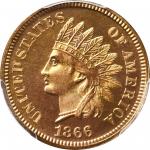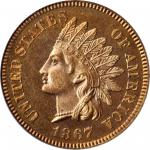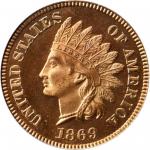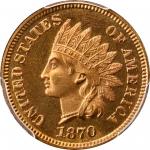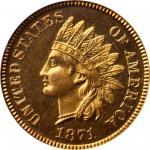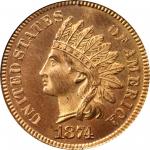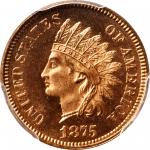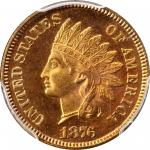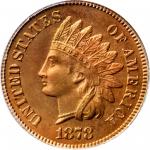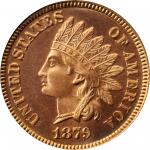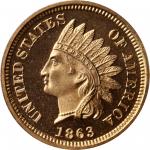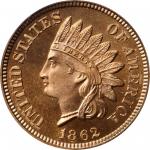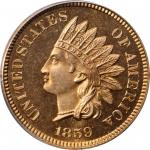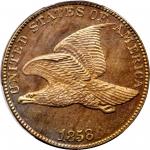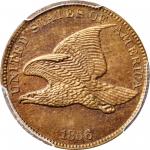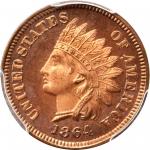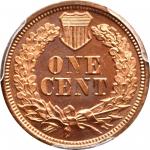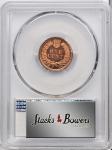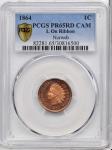1864 Indian Cent. Bronze. L on Ribbon. Snow-PR2. Proof-65 RD Cameo (PCGS).Offered is a simply outstanding example of this classic rarity among Proof small cents. Both sides exhibit vivid medium rose color dusted with pale reddish-silver tinting. The fields are well mirrored and form a splendid backdrop to satiny devices, resulting in the Cameo designation from PCGS. The strike is razor sharp from the rims to the centers, and the appearance is smooth and appealing. An impressive provenance that includes one of the greatest numismatic collections ever assembled enhances the desirability of this rare and beautiful specimen.The 1864 L on Ribbon in Proof format ranks as the foremost delicacy in the Indian cent series. PCGS CoinFacts estimates a population of just 30 to 35 pieces, while A Guide Book of United States Coins suggests 20+ as the mintage. As the Proof 1864 with L is a classic rarity, no doubt some of the certification numbers include resubmissions. Remarkably, despite the tiny population, there are three known die varieties of 1864 L on Ribbon Proofs, designated by Rick Snow as PR1, PR2 and PR3 in the 3rd edition (2014) of his Flying Eagle & Indian Cent Attribution Guide. The variety most frequently seen is PR2, offered here, which has an extant population of 13 or 14 coins and appears to comprise more than half of the surviving supply. PR1 has a known population of just eight or nine specimens. The rarest variety is PR3, which is currently represented by a sole known example (as PR1 and PR3 are very similar, some coins now listed as PR1 may eventually be reassigned as PR3). The easiest way to distinguish between the three varieties is by the placement of the date digits with respect to the bust truncation and the dentils, although PR2 is further identified by a prominent die line at the rear of Libertys jaw below the ear and heavy die lines on the reverse off the leaf tips at 8 oclock. The presently offered specimen is included in Snows census of PR2 examples. As information concerning these Proofs is not widely known we present the following:Snow-PR1. Original. 1 in date directly below the neck tip. No spine from curl. Snow: The obverse die is polished somewhat unevenly, with more space between the denticles at 3:00 and 9:00 than at 12:00 and 6:00. The reverse die was used earlier to strike some 1864 (without L) bronze Proof cents. This is the original die pair.Snow-PR2. Restrike. Date is significantly to the right of the tip of the neck, with the left side of the 1 in the date being an obvious check point. A tiny spine (about 1.5 mm) extends downward to the left from the curl below the ear into Libertys neck. The reverse seems to be from the same die used to strike the 1863 L on Ribbon pattern cents, but in a later state. Rick Snow and Q. David Bowers believe these were made for collectors in 1871; i.e., they are restrikes. (Cf. Norweb Collection, Part I, 1987, lot 156.) John Dannreuther, who is currently compiling a master work on United States Proof coins from the early 19th century onward and who has made some remarkable discoveries, reports that Proof 1864 Small Motto two-cent pieces also exist in restrike form and suggests that they may have been struck around 1871.The following suggested scenario is from Q. David Bowers 1996 study (before Snow-PR3 was discovered, now unique) and tells of the two main varieties -- originals and restrikes: Late in the 1864 year when the new hub with L on ribbon was introduced into the cent series, Proofs produced at that time were made of the new style and routinely sold to collectors who ordered them. Such orders would have straggled in, for traditionally most Proof minor coins in a given year were sold early in the year. At the time, there was no numismatic interest in or knowledge of the hub change, and no coin collectors noticed that certain late-1864 bronze Proofs had the L on ribbon. For that reason, the mintage was small and simply limited to those needed to fill orders that came in. This is truly remarkable. Many years ago when Q. David Bowers began studying certain early coins in detail, including examining nearly all coin auction catalogs of the 19th century, he expected to see the variety with L listed. No such find! It seems that it was not until about 1871 that collectors were aware of the tiny L on ribbon and sought to buy 1864 Proof bronze cents with this feature, but specimens were few and far between. The solution was a simple one: A new obverse Proof die dated 1864 and with the L on ribbon was created, and additional Proofs were made. The evidence for this is provided by this die sequence in the words of Rick Snow, here lightly paraphrased and expanded:Among Proof 1864 L Proof cents, the reverse of Die Pair 1 has been matched to the reverse of a regular no-L 1864 Proof bronze cent. Thus, Die Pair 1 can definitely be assigned original Proof status. A copper-nickel [pattern; Judd-358, Pollock-429] 1864 L cent I [Richard Snow] [once had] in stock is also a Die Pair 1 coin and was probably struck in 1864. The aluminum strikings of the 1864 L cent (Judd-361, Pollock-432) and the 1863 L cents in various metals (J-301, P-363 in bronze; J-302, P-365 in copper-nickel; J-403, P-367 in aluminum) are all paired with the same reverse used to create 1864 L Proof bronze cents from Die Pair 2, but these various patterns are from an earlier die state. This indicates that the 1863 with-L cents were struck before the Die Pair 2 1864 L bronze Proofs.However -- and here is the telling part -- this same reverse die can be found on 1869 aluminum strikings (J-671, P-747) and regular-issue Proof 1870 and 1871 bronze cents. The striking order of this reverse die -- as observed from coins together at the same time for side-by-side comparison -- is as follows: 1863 L in bronze (Narrow Bust) - 1863 L in copper-nickel (Narrow Bust) - 1869 in aluminum - 1870 regular bronze Proof - 1871 regular bronze Proof (variety with 71 apart) - 1864 L regular bronze Proof - 1871 regular bronze Proof (variety with 71 numerals close).”This clearly shows that the Die Pair 2 Proof 1864 L cents were struck no earlier than 1871 and were made as restrikes for the collector market. It also shows that in 1871 the Mint was making up restrikes for numismatists.This restriking activity from the 1871 era is not a revelation, as, for example, the so-called restrike Proof 1801, 1802, and 1803 silver dollars are believed to have been made around this time, and a glance at the Judd or Pollock books will reveal many unusual mulings and off-metal strikes. Of course, restrikes are avidly collected in their own right, and in some instances (such as Proof half cents of the 1830s and 1840s) rare varieties of restrikes sometimes bring higher prices than originals.Snow-PR3. Struck from the same reverse as Die Pair 1, the obverse identifiable by minor repunching to the digits 864 in the date. Presently unique, and discovered in the Pennsylvania Estate, a collection assembled from the 1930s through the 1950s. This coin set a record price at the time for a small cent of any type or issue when it sold for $132,000 in Heritages Long Beach Sale of June 2002.From the ESM Collection. Earlier ex Michael Coleman; Empire Coin Co.; Ambassador and Mrs. R. Henry Norweb; our (Bowers and Merenas) sale of the Norweb Collection, Part I, October 1987, lot 156; Heritages sale of the New York Collection of 1864-L Indian Cents, September 2013 Long Beach Signature Auction, lot 6235; Heritages Chicago ANA Signature Auction of August 2014, lot 5533.


